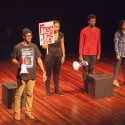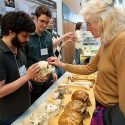CAVE of wonders: Exhibit pushes the boundaries of art, collaboration
In the year since the Wisconsin Institutes for Discovery opened at the University of Wisconsin–Madison, its resident researchers have gotten comfortable in their innovative new spaces.
Now comes a fun part. Behind a green curtain lies an extension of the facility’s capabilities. Lisa Frank’s “<1>: “der” //Pattern for a Virtual Environment” takes a $2.5 million device from the realm of research into fine art. As Frank expands her art from two dimensions to three, she demonstrates exciting possibilities for fields not traditionally connected with science. Her exhibit runs Dec. 9-16 at the Discovery building, 330 N. Orchard St.

A view of the art exhibit inside the CAVE at the Wisconsin Institutes for Discovery. Lisa Frank’s exhibit runs through Dec. 16.
The Cave Automatic Virtual Environment (CAVE), located within the Discovery building, projects images onto the walls, floor and ceiling of a 10-foot cube. With high-resolution, 3D graphics and glasses tracking a user’s gaze, the CAVE immerses users in an interactive experience. Fewer than 10 CAVE environments worldwide are fully immersive. Frank’s exhibit may mark the first use of a CAVE in art.
The CAVE is the centerpiece of the Living Environments Laboratory (LEL), led by Patricia (Patti) Brennan, Lillian S. Moehlman-Bascom Professor of Nursing and Industrial Engineering. Brennan and her colleagues saw many products and services designed without environment-specific testing. Immersion in the “living environment” of a kitchen, for example, reinforces actual motions used: opening a cabinet, pouring water or cradling a baby while making a bottle.
“Patti wanted to create a space to quickly prototype new devices. Virtual reality was the way to do that,” says Kendra Jacobsen, associate director of the LEL. “We can upload homes, kitchens, bathrooms, and put different tools in them. You can quickly evaluate how something would be used.”
Frank came to Madison after a long career in commercial textile design. This exhibit rounds out her MFA degree, which she has pursued while directing the Design Gallery at the School of Human Ecology. When Frank experimented with integrating technology into her work, Diane Sheehan, chair of Frank’s graduate committee, suggested using the CAVE to push Frank out of her comfort zone.
“You go from the expansive nest landscape to this macro world on the level with mushrooms and roots. You’re seeing equally inaccessible worlds.”
Lisa Frank
Frank uses patterns to create order out of nature’s elegant chaos. The interplay between natural and constructed worlds helps orient visitors to the facility’s artificial environment.
In September, Frank began collaborating with graduate student Nathan Mitchell, a computer scientist with virtual-reality expertise. The partnership demonstrates one major challenge of new technology: different languages of design. Frank uses computers for pattern development and photo manipulation; Mitchell leans toward 3D modeling and programming. Together, their skills enhance each other’s work. Mitchell introduced Frank to video games, exploring architectural maps and first-person perspectives. Frank shared art from William Morris and Henri Rousseau, emphasizing the marriage of texture with form.
The exhibit’s scenes move from expansive to microscopic, formal to earthy. In the first scene, viewers can jump from a lofty bird’s nest onto the ground or crawl inside an egg. In another scene, the calm green of a Victorian room comes from repeated eucalyptus leaves. Stones from the Ice Age Trail form an inlaid floor, reminiscent of the Capitol rotunda.
“I like bringing something that viewers wouldn’t normally have seen,” says Frank. “You go from the expansive nest landscape to this macro world on the level with mushrooms and roots. You’re seeing equally inaccessible worlds.”
Computer science graduate student Nathan Mitchell moves through a scene from Lisa A. Frank’s MFA exhibit, presented by the Design Gallery of the UW–Madison School of Human Ecology.
This innovative 3D experience hints at new research opportunities, particularly in the humanities.
“Some of the real power of art is being there,” says Jacobsen. “Walking through a cathedral, the way the art changes as you’re moving creates a whole other experience.”
Ann Smart Martin, Stanley and Polly Stone Professor of Art History, has conducted preliminary experiments in the CAVE on interactions between different types of light and wood. The CAVE simulates how a wood “skin” covers varied surfaces, from walls to furniture.
“Artisans and others talk about the way different woods work with different types of light in different environments,” says Martin. “I can find discussions in 17th- and 18th-century documents. But how do we see that today? I’m arguing that the experience of different things in different lighting conditions explains why certain styles succeeded.”
Accurate representations of light and shadow remain a significant problem in computer graphics. Martin reached out to postdoctoral fellow Kevin Ponto, who had connected Mitchell with both Martin and Frank. The two used a research model from Steve Marschner, a computer scientist at Cornell University. Their conversations encourage synergy between two vastly different disciplines.
“Computer gaming drives this,” says Martin. “You’re not just seeing shadows on the back of a 3D object; it involves all the ways light is reflected and refracted around a room. My problem — asking a question in a historic period — is just a small permutation of a much larger issue.”
Martin nudges others on campus — particularly in the humanities — to experiment with the CAVE’s capabilities. Given a growing core of people with the necessary technical skills, she hopes more researchers will take advantage of the technology.
Martin’s experience delights the CAVE’s caretakers. “It’s turning out to mean different things to different people. We’re careful not to proscribe what it could be,” says Jacobsen. “Adding a new piece can add new directions to existing ideas: taking something small and making it really big, walking inside something you’d never be able to walk inside — a cell, or the grain of wood. If you can imagine it, we can probably make it happen.”
For more information on the hours for Frank’s exhibit, click here. Those who would like to reserve a 15-minute visit can email designgallery@mail.sohe.wisc.edu.



